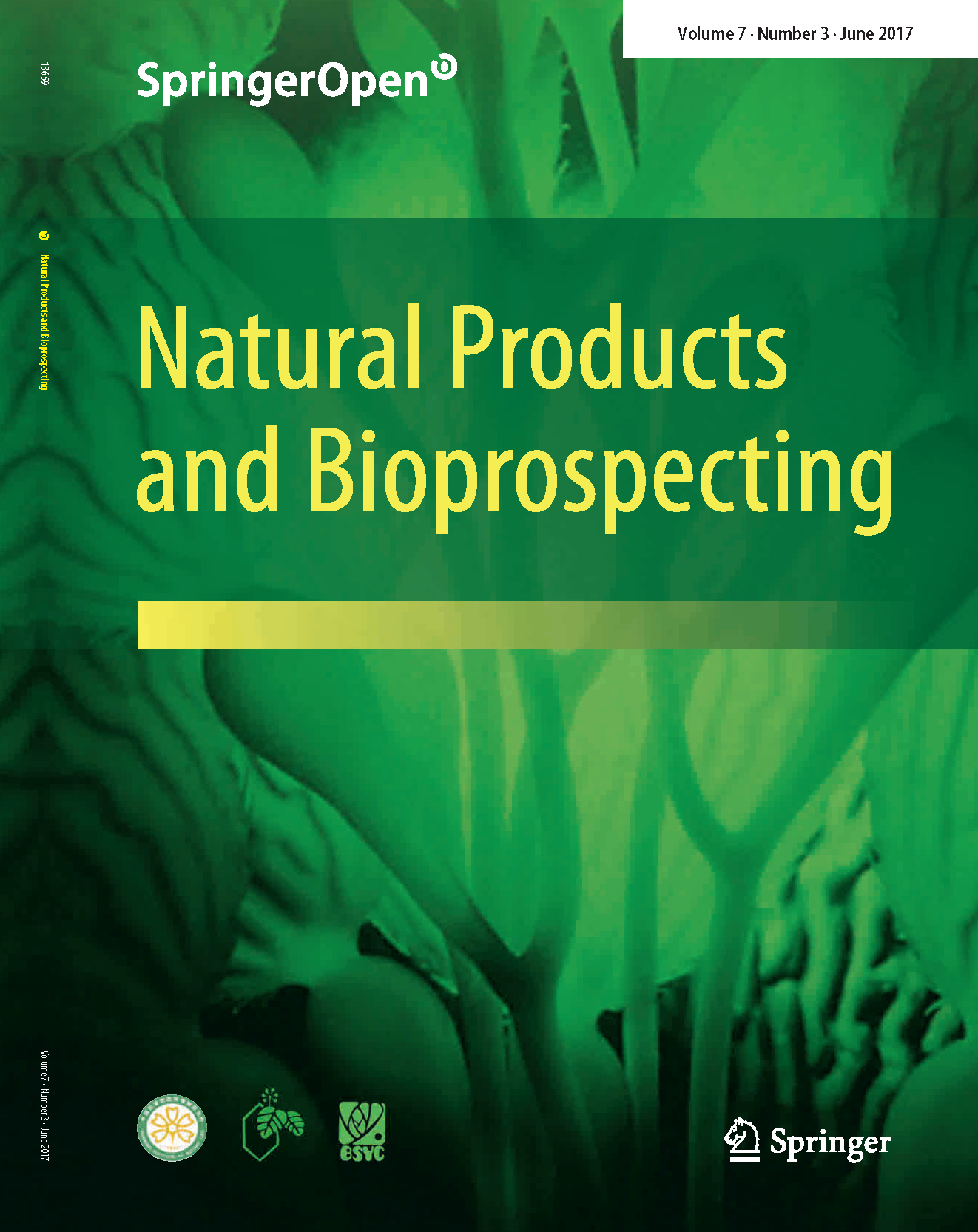|
|
Pyrocincholic acid 3β-O-β-D-quinovopyranosyl-28-O-β-D-glucopyranoside suppresses adipogenesis and regulates lipid metabolism in 3T3-L1 adipocytes
Collect
Li Peng, Yanting Lu, Yuhui Xu, Jing Hu, Fang Wang, Yumei Zhang, Wenyong Xiong
Natural Products and Bioprospecting. 2017, 7 (3): 225-234.
DOI: 10.1007/s13659-017-0127-9
Obesity is crucially involved in many metabolic diseases, such as type 2 diabetes, cardiovascular disease and cancer. Regulating the number or size of adipocytes has been suggested to be a potential treatment for obesity. In this study, we investigated the effect of pyrocincholic acid 3β-O-β-D-quinovopyranosyl-28-O-β-D-glucopyranoside (PAQG), a 27-nor-oleanolic acid saponin extracted from Metadina trichotoma, on adipogenesis and lipid metabolism in 3T3-L1 adipocytes. The 3T3-L1 pre-adipocytes were incubated with vehicle or PAQG for 6 days in differentiation process. PAQG significantly reduced the adipogenesis, adiponectin secretion and the expression level of key transcription factors related to adipogenesis, such as PPARγ, C/EBPβ, C/EBPα, and FABP4. Moreover, PAQG increased the levels of FFA and glycerol in medium and reduced TG level in mature adipocytes. Interestingly, PAQG not only promoted the activation of AMPK and genes involved in fatty oxidation including PDK4 and CPT1a, but also inhibited those genes involved in fatty acid biosynthesis, such as SREBP1c, FAS, ACCa and SCD1. In conclusion, PAQG inhibits the differentiation and regulates lipid metabolism of 3T3-L1 cells via AMPK pathway, suggesting that PAQG may be a novel and promising natural product for the treatment of obesity and hyperlipidemia.
References |
Related Articles |
Metrics
|
|
|
Antiparasitic Sesquiterpenes from the Cameroonian Spice Scleria striatinux and Preliminary In Vitro and In Silico DMPK Assessment
Collect
Kennedy D. Nyongbela, Fidele Ntie-Kang, Thomas R. Hoye, Simon M. N. Efange
Natural Products and Bioprospecting. 2017, 7 (3): 235-247.
DOI: 10.1007/s13659-017-0125-y
The antiparasitic activity and preliminary in vitro and in silico drug metabolism and pharmacokinetic (DMPK) assessment of six isomeric sesquiterpenes (1-6), isolated from the Cameroonian spice Scleria striatinux De Wild (Cyperaceae) is reported. The study was prompted by the observation that two of the compounds (1 and 2) exhibited varying levels of antiparasitic activity on Plasmodium falciparum, Trypanosoma brucei rhodesiense, Trypanosoma cruzi and Leishmania donovani. The in silico method employed a total of 46 descriptors, calculated using Schrödinger QikProp software. 18 of these molecular descriptors that are often used to predict DMPK profiles of drug-like molecules have been selected for discussion. In vitro experimental assessment of metabolic stability made use of human liver microsomes, which was used to correlate theoretical predictions with experimental findings. Overall, the test compounds have been found to have acceptable physicochemical properties and fall within the ranges associated with “drug-like” molecules. Moreover, the compounds exhibited minimal degradation in incubations with human liver microsomes. Although some of these compounds have been reported previously (1, 2, 4 and 5), this is the first report on their antiparasitic activities, as well as assessment of their DMPK profiles. These results have therefore provided a window for further development of this novel class of sesquiterpene molecules as potential antiparasitic drugs.
References |
Related Articles |
Metrics
|
|
|
In silico Discovery of Novel FXa Inhibitors by Pharmacophore Modeling and Molecular Docking
Collect
Yinglan Pu, Hui Liu, Yeheng Zhou, Jiale Peng, Yaping Li, Penghua Li, Yingying Li, Xingyong Liu, Li Zhang
Natural Products and Bioprospecting. 2017, 7 (3): 249-256.
DOI: 10.1007/s13659-017-0126-x
Coagulation Factor Xa (FXa) is the crucial enzyme at the convergent point of the intrinsic and extrinsic coagulation pathways. The inhibition of FXa is an effective approach against thrombotic diseases. In the present study, a specific strategy is reported to discover 10 novel FXa inhibitors based on ligand-based (pharmacophore) virtual screening and molecular docking analysis from a dataset of specs(containing 220000 molecules). The binding modes analysis provide insights into the contribution of particular structural moieties of the compounds towards their activity against FXa, and 10 novel structural compounds were discovered as potent candidate molecules. This work could be helpful in further design and development of FXa inhibitors.
References |
Related Articles |
Metrics
|
|
|
Two New Compounds from Schisandra propinqua var. propinqua
Collect
Miao Liu, Zheng-Xi Hu, Yuan-Qing Luo, Min Zhou, Wei-Guang Wang, Xiao-Nian Li, Xue Du, Jian-Xin Pu, Han-Dong Sun
Natural Products and Bioprospecting. 2017, 7 (3): 257-262.
DOI: 10.1007/s13659-017-0129-7
Schisanpropinoic acid (1), a new bergamotane sesquiterpenoid, and schisanpropinin (2), a new tetrahydrofuran lignan with a rare epoxyethane unit, were identified from the stems and leaves of Schisandra propinqua var. propinqua. Their structures were determined based on comprehensive spectroscopic and mass spectrometric analysis. The absolute configuration of 1 was determined by X-ray analysis. Compounds 1 and 2 were tested for their cytotoxic activity against five human tumor cell lines.
References |
Related Articles |
Metrics
|
|
|
New Azulene-Type Sesquiterpenoids from the Fruiting Bodies of Lactarius deliciosus
Collect
Michel Feussi Tala, Jianchun Qin, Joseph T. Ndongo, Hartmut Laatsch
Natural Products and Bioprospecting. 2017, 7 (3): 269-273.
DOI: 10.1007/s13659-017-0130-1
In the 1H NMR-guided fractionation of extracts from the edible mushroom Lactarius deliciosus, two new azulene-type sesquiterpenoids, 7-isopropenyl-4-methyl-azulene-1-carboxylic acid (1) and 15-hydroxy-3,6-dihydrolactarazulene (2), together with seven known compounds were characterized. Their structures were determined on basis of spectroscopic evidence, as well as by comparing with literature data. Amongst the known metabolites, the 13C NMR assignment of 15-hydroxy-6,7-dihydrolactarazulene (3) is reported here for the first time. Moreover, 7-acetyl-4-methylazulene-1-carbaldehyde (5) displayed a moderate antibacterial activity against Staphylococcus aureus.
References |
Related Articles |
Metrics
|
|

